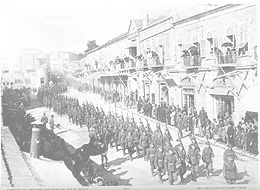British Mandate
From the end of WWI until the mid-20th century, Great Britain, along with France,
controls vast stretches of the Middle East. Jerusalem is now the capital of the British mandate. Ruling on behalf of the League of Nations,
Britain is unable to make good on promises of national independence made to both Jews and Arabs. Exhausted by the task of policing Jewish
immigration and Arab rioting, Britain leaves with an all-out war between Arabs and Jews on the horizon.
Divided
City
The
UN partition plan for Palestine proposes an internationalization of Jerusalem.
Instead, as a result of the 1948-9 War of Independence, Jerusalem is divided
between the modern State of Israel and the Hashemite Kingdom of Jordan.
Under the Israeli Flag
In June 1967, during
the Six Days War, the Israel Defense Forces (IDF) take East Jerusalem along
with the rest of the West Bank area that, since 1949, had been under the control
of the Hashemite Kingdom of Jordan. For the first time since antiquity, the city is
under the control of a Jewish state. For the first time
ever, Christian and Muslim holy places are under the control of a
Jewish state.
WWII
and the Rebellion in Palestine
With the beginning
of WWII, the British shut down Jewish immigration, at a time when it is most
needed. This generates an all out rebellion against the mandatory rule which
ends in ignominy.
Reviewing the
situtation, the United Nations General Assembly votes to partition Palestine
and to internationalize Jerusalem.
War
of Independence/Al Naqba
As
British troops leave, armies from neighboring countries attack the newly independent
State of Israel. In a dramatic turn of events, the Jewish State survives its
first military test and consolidates the areas under its control, including
Western Jerusalem.
For
Palestinians, this begins an enduring exile and the ongoing struggle for national
independence.
| Holy City: Jerusalem in time, space and imagination |
 |
|
Modern Jerusalem 1917-2000 |
|

